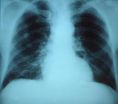(Press-News.org) CHAMPAIGN, Ill. — The bacterium Streptococcus pneumoniae – which can cause pneumonia, meningitis, bacteremia and sepsis – likes to share its antibiotic-defeating weaponry with its neighbors. Individual cells can pass resistance genes to one another through a process called horizontal gene transfer, or by "transformation," the uptake of DNA from the environment.
Now researchers report that they can interrupt the cascade of cellular events that allows S. pneumoniae to swap or suck up DNA. The new findings, reported in the journal PLoS ONE, advance the effort to develop a reliable method for shutting down the spread of drug resistance in bacteria.
"Within the last few decades, S. pneumoniae has developed resistance to several classes of antibiotics," said University of Illinois pathobiology professor Gee Lau, who led the study. "Importantly, it has been shown that antibiotic stress – the use of antibiotics to treat an infection – can actually induce the transfer of resistance genes among S. pneumoniae. Our approach inhibits resistance gene transfer in all strains of S. pneumoniae, and does so without increasing selective pressure and without increasing the likelihood that resistant strains will become dominant."
Lau and his colleagues focused on blocking a protein that, when it binds to a receptor in the bacterial cell membrane, spurs a series of events in the cell that makes the bacterium "competent" to receive new genetic material. The researchers hypothesized that interfering with this protein (called CSP) would hinder its ability to promote gene transfer.
In previous work published late last year in the journal PLoS Pathogens, Lau's team identified proteins that could be made in the lab that were structurally very similar to the CSP proteins. These artificial CSPs can dock with the membrane receptors, block the bacterial CSPs' access to the receptors and reduce bacterial competence, as well as reducing the infectious capacity of S. pneumoniae.
In the new study, the researchers fine-tuned the amino acid structure of more than a dozen artificial CSPs and tested how well they inhibited the S. pneumoniae CSPs. They also tested their ability (or, more desirably, their inability) to mimic the activity of CSPs in bacterial cells.
"The chemical properties of individual amino acids in a protein can greatly influence the protein's activity," Lau said.
The team identified several artificial CSPs that both inhibited the bacterial CSPs and reduced S. pneumoniae competence by more than 90 percent.
"This strategy will likely help us reduce the spread of antibiotic-resistance genes among S. pneumoniae and perhaps other species of streptococcus bacteria," Lau said.
INFORMATION:
The study team included researchers from Sun-Yat-Sen University in Guangdong, China. The National Institutes of Health and the University of Illinois Research Board Arnold O. Beckman Research Endowment partially supported this work.
Editor's notes: To reach Gee Lau, call 217-333-5077; email geelau@illinois.edu.
The paper, "Saturated Alanine Scanning Mutagenesis of the
Pneumococcus Competence Stimulating Peptide Identifies Analogs That
Inhibit Genetic Transformation," is available online.
Scientists target bacterial transfer of resistance genes
2012-10-25
ELSE PRESS RELEASES FROM THIS DATE:
Research findings breathe new life into lung disease
2012-10-25
TORONTO, Oct. 24, 2012--It turns out the muscle cells on the outside of blood vessels have been wrongly accused for instigating lung disease. New research shows that while these muscle cells are responsible for constricting or dilating the blood vessels, they are not responsible for sensing the amount of oxygen that gets to the lungs. That message comes from the endothelial cells – special cells that line the blood vessels – along a "signalling pathway."
When a person is low on oxygen, blood vessels throughout the body expand to improve the delivery of this vital molecule ...
Is obesity irreversible? Timing is key in weight loss, U-M research shows
2012-10-25
ANN ARBOR, Mich. — Joint research between the University of Michigan and the Argentina-based National Council of Science and Technology (CONICET) has shed light on one of the most frustrating mysteries of weight loss – why the weight inevitably comes back.
A novel animal model showed that the longer mice remained overweight, the more "irreversible" obesity became, according to the new study that appeared online ahead of print Oct.24 in the Journal of Clinical Investigation.
Over time, the static, obese state of the mice reset the "normal," body weight set point to ...
Mesh-covered stent helps restoration of blood flow in heart attack patients undergoing PCI
2012-10-25
MIAMI, FL – OCTOBER 24, 2012 – A clinical trial found that the use of a next generation, micronet, mesh-covered stent demonstrated improved restoration of blood flow to heart tissue, compared to the use of either bare-metal or drug-eluting stents in heart attack patients undergoing angioplasty. Results of the MASTER trial were presented today at the 24th annual Transcatheter Cardiovascular Therapeutics (TCT) scientific symposium and will appear in the November 6th issue of the Journal of the American College of Cardiology. Sponsored by the Cardiovascular Research Foundation, ...
Knee replacement not an 'easy solution' for obese patients
2012-10-25
ROSEMONT, IL–Obese patients have a greater risk of complications following total knee replacement surgery, including post-surgical infections, according to a new literature review recently published in the Journal of Bone and Joint Surgery (JBJS). Because of complications, obese patients are more likely to require follow-up surgery (revision).
Obesity is reaching epidemic proportions, particularly in the United States, and is a well-documented risk factor for the development of osteoarthritis. Arthritis is initially treated nonsurgically, but total joint replacement often ...
Ghost busting
2012-10-25
The fourth installment of the Paranormal Activity films topped the box office last week. Television channel SyFy's hit show Ghost Hunters scares up big ratings, and has spawned copycat series on networks ranging from Biography to Animal Planet.
The omnipresence of paranormal entertainment piqued the interest of Paul Brewer, professor of communication, who wondered what makes viewers believe—or disbelieve— what they see on the screen.
His resulting study, recently published in the journal Science Communication, examines the influence of media messages about paranormal ...
Measuring Table-Top Accelerators’ State-of-the-Art Beams
2012-10-25
Part Two: Slicing through the electron beam
Wim Leemans of Berkeley Lab's Accelerator and Fusion Research Division heads LOASIS, the Laser and Optical Accelerator Systems Integrated Studies, an oasis indeed for students pursuing graduate studies in laser plasma acceleration (LPA). Among the most promising applications of future table-top accelerators are new kinds of light sources, in which their electron beams power free electron lasers.
"If our LPA electron bunches had good enough quality for free electron lasers – and were really only femtoseconds long – we should ...
NASA sees Tropical Storm Sandy approaching Jamaica
2012-10-25
NASA satellites are closely monitoring Tropical Storm Sandy in visible and infrared light as it approaches Jamaica. Sandy is now responsible for hurricane and tropical storm warnings and watches from Jamaica to Cuba, the Bahamas and southern Florida. Sandy is expected to become a hurricane before it reaches Jamaica and Cuba.
On Oct. 23, 2012 at 1545 UTC (11:45 a.m. EDT), the Moderate Resolution Imaging Spectroradiometer (MODIS) instrument captured a visible image of Tropical Storm Sandy when its center was a couple of hundred miles south of Jamaica. Sandy's clouds filled ...
Challenging Parkinson's dogma
2012-10-25
Scientists may have discovered why the standard treatment for Parkinson's disease is often effective for only a limited period of time. Their research could lead to a better understanding of many brain disorders, from drug addiction to depression, that share certain signaling molecules involved in modulating brain activity.
A team led by Bernardo Sabatini, Takeda Professor of Neurobiology at Harvard Medical School, used mouse models to study dopamine neurons in the striatum, a region of the brain involved in both movement and learning. In people, these neurons release ...
Self-affirmation enhances performance, makes us receptive to our mistakes
2012-10-25
Life is about failure as much as it is about success. From the mistakes we make at work or school to our blunders in romantic relationships, we are constantly reminded of how we could be better. By focusing on the important qualities that make us who we are – a process called self-affirmation – we preserve our self-worth in the face of our shortcomings.
Self-affirmation has been shown to have powerful effects – research suggests that it can minimize the anxiety, stress, and defensiveness associated with threats to our sense of self while keeping us open to the idea that ...
NASA sees tiny Tropical Storm Tony traveling
2012-10-25
Satellite imagery indicated that Tropical Storm Tony is a small, compact storm, traveling through the central Atlantic Ocean.
On Oct 23, Tropical Depression 19 strengthened into Tropical Storm Tony in the central Atlantic Ocean. NOAA's GOES-13 satellite captured an image of Tony on Oct. 24 at 7:45 a.m. EDT that revealed that Tony is relatively small as it moves through the central Atlantic. Tropical storm force winds extend outward up to 70 miles (110 km) from the center. Tony is just over 140 miles in diameter as seen on the GOES-13 image. The GOES-13 satellite image ...





